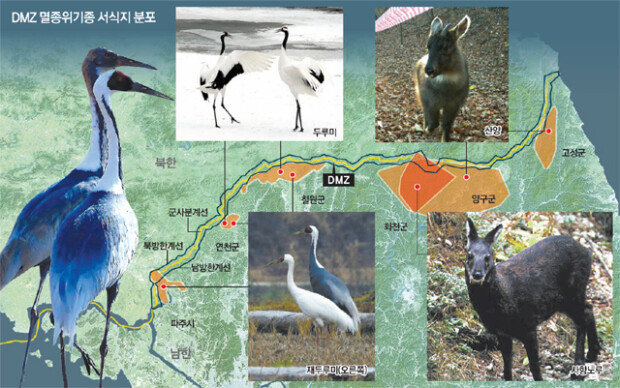101 endangered wild species discovered in DMZ
101 endangered wild species discovered in DMZ
Posted June. 14, 2018 07:26,
Updated June. 14, 2018 07:26

The Demilitarized Zone has been untouched for a few decades, but is known to be home to 101 endangered wild species.
The National Institute of Ecology, affiliated by the Ministry of Environment, announced on Wednesday that 37.8 percent of the 267 endangered species in Korea are living in the DMZ, which shows the significance of the area as a key habitat for wild species in danger of extinction. The data is the outcome of analyzing and comparing accumulated research data of three regions (the east coast, east mountainous area, west plains) within the DMZ from 2014 to 2017, with previous data accumulated since 1974.
Among the 101 wild species confirmed to be living in the DMZ, a total of 18 first-grade (critically endangered) species (wild animals and plants of which population has dramatically decreased and at risk of extinction) and 83 second –grade (endangered to vulnerable) species (those at risk of extinction in the near future) have been discovered.
The musk deer, classified as first-grade under the Korean endangered specifies classification system, is at risk of extinction, which is classified as critically endangered on the IUCN Red List.
It is estimated that there are a total of 5,929 specifies living in the demilitarized zone, including endangered species. Yang-gu, Goseong (eastern area), Yeoncheon (western area), Hwacheon and Cheorwon (middle area) are known to be particularly rich in biodiversity.
Experts say that both Koreas should promote the DMZ as a UNESCO biosphere reserve so that it can be preserved with international support. “The World Heritage Committee ambassadors at UNCESCO have praised DMZ as a wonderfully preserved natural heritage, with potential to be registered as a natural reserve immediately,” Korean Ambassador to UNESCO Lee Byung-hun told The Dong-A Ilbo. South Korea had applied for registry in 2012, but was thwarted by opposition from North Korea.
“The DMZ is not only home to various wildlife, but also to wetlands,” said Kim Kwi-gon, professor emeritus at Seoul National University. “The region should be classified according to value, such as key areas with high preservation value and buffer areas. Other areas could be designated for economic cooperation and travel.”
whatsup@donga.com
Headline News
- Med professors announce intention to leave hospitals starting Thursday
- Bridge honoring Sgt. Moon Jae-sik unveiled in Pennsylvania
- Chief of Staff Chung tells presidential secretaries to stay away from politics
- US FTC bans noncompete agreements
- N. Korea launches cyberattacks on S. Korea's defense companies







